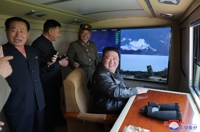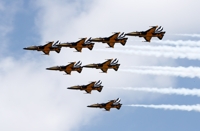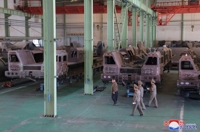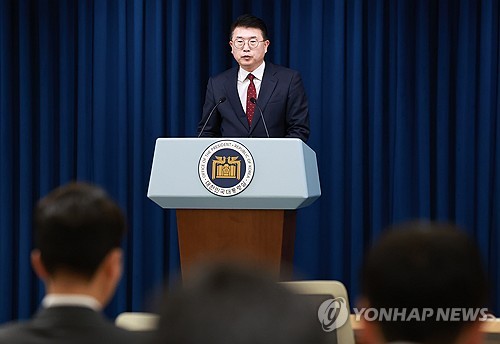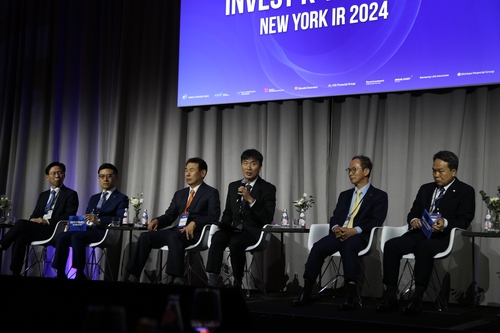(LEAD) Joint naval exercise strengthening S. Korea-U.S. alliance
(ATTN: ADDS photo, more admiral comments in 4-6 paras, South Korean Rear Adm. Kim's comment in 7th para)
By Choi Kyong-ae
USS RONALD REAGAN, South Sea, Oct. 14 (Yonhap) -- The flight deck of the USS Ronald Reagan aircraft carrier was bustling with sailors and planes Friday to demonstrate air flight operations to South Korean reporters who arrived on board after an hour-long flight from a U.S. air base.
The first thing that greeted reporters was pilots in the cockpits of their Super Hornet fighter jets getting ready to take off and the flight deck crew assisting in the operations in waters some 240 kilometers from Osan Air Base in Pyeongtaek, south of Seoul, and north of Jeju Island.
Before the planned demonstration, Rear Adm. Charles Williams, commander of the carrier battle group of the U.S. 7th Fleet, delivered a short briefing on the ongoing joint exercise between South Korean and U.S. navies amid ever-growing nuclear and missile threats from North Korea.
"Our operations on the Korean Peninsula are part of an ongoing presence and ongoing partnership with our Republic of Korea Navy counterparts. The U.S. Navy has been in and around the peninsula for more than five decades now," the flag officer said.
"I think the work that we have done in company with our counterparts has proven to not only strengthen our alliance but also make both of us better mariners, more professional and better partners together."
The Ronald Reagan strike group includes several warships, and they're all here as part of exercise Invincible Spirit, he said.
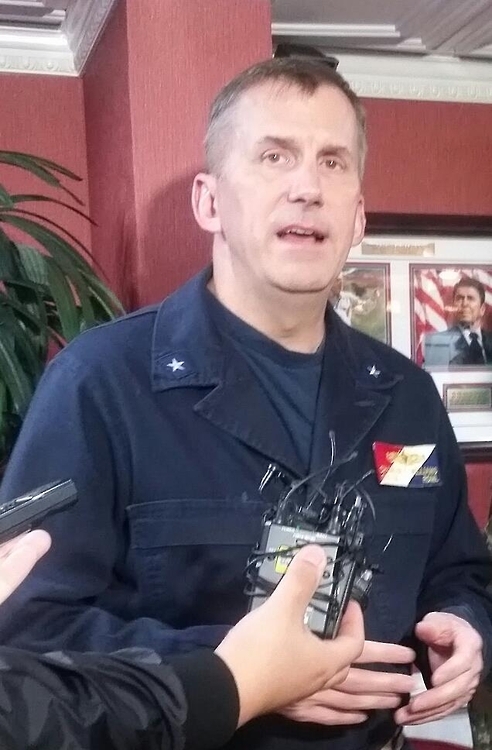
This photo, taken on Oct. 14, 2016, shows Rear Adm. Charles Williams, commander of the carrier battle group of the U.S. 7th Fleet, delivering a short briefing on the ongoing joint naval exercise between South Korea and the U.S. near the Korean Peninsula. (Yonhap)
His South Korean counterpart Kim Jeong-soo said, "Through the operational cooperation between the ROK and the U.S. we will always be ready to respond to any type of provocation from North Korea."
After the briefing, elaborating on the meaning of the combined exercise, Lt. Commander Aaron V. Kakiel, a spokesman for Carrier Strike Group 5 to which the nuclear carrier belongs, said, "The exercise has been planned for a very long time. We've been working with our Korean counterparts to exercise our interoperability in this area. It is not a direct response to any (provocative) actions (by any country). It is meant to be training for us to work together for a stronger alliance."
During the 30-minute demonstration, nine fighter jets took off and 15 fighter jets made landings. Most of the planes were FA-18 Super Hornets. Others were the E-2C Hawk Eye early warning plane and the EA-18G Growler, the fleet's electronics warfare plane.
U.S. and South Korean navy officials said the joint exercise will further improve interoperability to be fully ready to strike back against any military attacks by North Korea.
Besides the Nimitz-class nuclear-powered aircraft carrier, the strike group also includes Ticonderoga-class guided-missile cruiser USS Chancellorsville (CG-62) and Arleigh Burke-class guided missile destroyers USS Barry (DDG-52), USS John S. McCain (DDG-56) and USS Curtis Wilbur (DDG-54).
The 333-meter long USS Ronald Reagan is the flagship of CSG 5 home-ported at Yokosuka, Japan, as part of the U.S. Seventh Fleet. It has nearly 80 aircraft on board ranging from fighter jets to helicopters and has a crew of 5,000 personnel.
The Ronald Reagan is the U.S. Navy's only forward-deployed aircraft carrier and strike group at the same time and can be used to counter threats posed by countries like North Korea.
This year alone, North Korea conducted two nuclear tests and test-launched multiple ballistic missiles, including a submarine-launched ballistic missile, escalating tensions on the Korean peninsula and in the region.
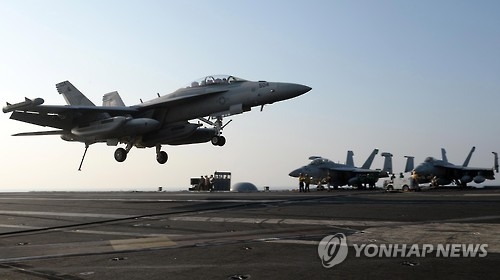
This photo taken on Oct. 14, 2016, shows a Super Hornet jet landing on the USS Ronald Reagan during a flight operation unveiled to South Korean reporters in the sea north of Jeju Island. (Yonhap)
After the six-day "Invincible Spirit" maritime maneuvers that end Saturday, the USS Ronald Reagan CSG is scheduled to make a port visit at Busan, South Korea's No. 1 port, on Sunday.
"While in port, Ronald Reagan CSG personnel will have the opportunity to visit and engage with their South Korean Navy partners and conduct cultural exchanges with local people," the U.S. naval command said.
The allies have applied the concept of "Korea Massive Punishment & Retaliation" (KMPR) to improve the strike capabilities of ship-to-ground missiles on top of the usual anti-ship and anti-air exercises.
The KMPR operational concept is aimed at decimating parts of Pyongyang, and envisions launching pre-emptive attacks on North Korean leader Kim Jong-un and the communist regime's military leadership if signs of the imminent use of nuclear weapons are detected.
kyongae.choi@yna.co.kr
(END)
-
 Thailand seeks extradition of S. Korean suspect in Pattaya murder
Thailand seeks extradition of S. Korean suspect in Pattaya murder -
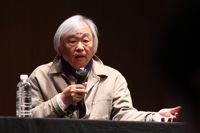 Paik Kun-woo's 1st Mozart album: a return to musical roots
Paik Kun-woo's 1st Mozart album: a return to musical roots -
 N. Korea's Kim, daughter attend ceremony for new street in Pyongyang
N. Korea's Kim, daughter attend ceremony for new street in Pyongyang -
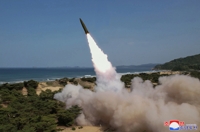 (2nd LD) N. Korea says it test-fired tactical ballistic missile with new guidance technology
(2nd LD) N. Korea says it test-fired tactical ballistic missile with new guidance technology -
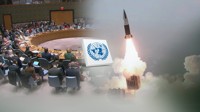 N. Korea slams U.N. members' sanctions enforcement as 'provocations'
N. Korea slams U.N. members' sanctions enforcement as 'provocations'
-
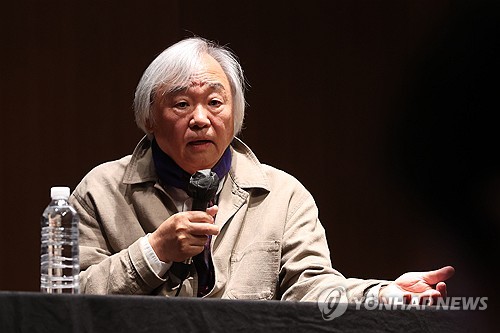 Paik Kun-woo's 1st Mozart album: a return to musical roots
Paik Kun-woo's 1st Mozart album: a return to musical roots -
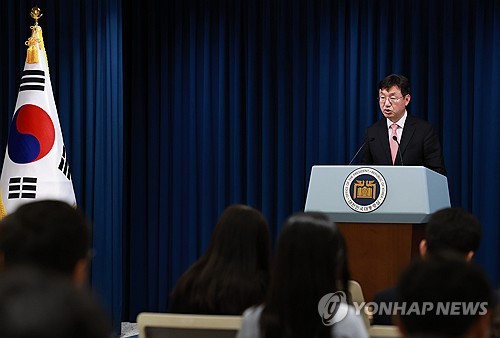 Yoon's office vows to firmly respond to unfair treatment of S. Korean companies amid Japan's pressure on Naver
Yoon's office vows to firmly respond to unfair treatment of S. Korean companies amid Japan's pressure on Naver -
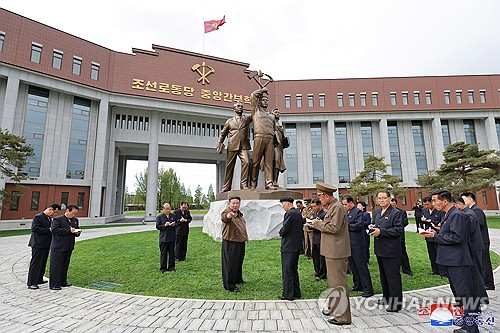 N.K leader visits newly built ruling party training school
N.K leader visits newly built ruling party training school -
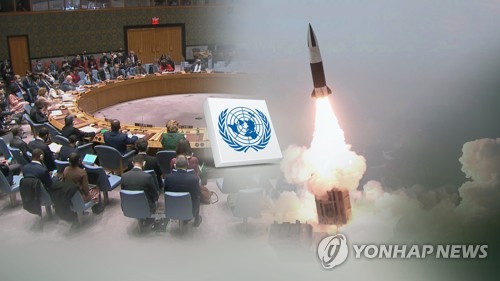 N. Korea slams U.N. members' sanctions enforcement as 'provocations'
N. Korea slams U.N. members' sanctions enforcement as 'provocations' -
 S. Korea, Malaysia discuss arms industry cooperation in Kuala Lumpur
S. Korea, Malaysia discuss arms industry cooperation in Kuala Lumpur
-
 (Yonhap Feature) S. Korean women scramble for 'safe breakup' after series of femicides by ex-boyfriends
(Yonhap Feature) S. Korean women scramble for 'safe breakup' after series of femicides by ex-boyfriends -
 NewJeans members submit petitions over court injunction in Hybe-ADOR conflict
NewJeans members submit petitions over court injunction in Hybe-ADOR conflict -
 (2nd LD) N. Korea says it test-fired tactical ballistic missile with new guidance technology
(2nd LD) N. Korea says it test-fired tactical ballistic missile with new guidance technology -
 Top U.S. negotiator for defense cost sharing talks arrives in Seoul
Top U.S. negotiator for defense cost sharing talks arrives in Seoul -
 HRNK report sheds light on human rights abuse of N. Korean nuclear scientists
HRNK report sheds light on human rights abuse of N. Korean nuclear scientists














